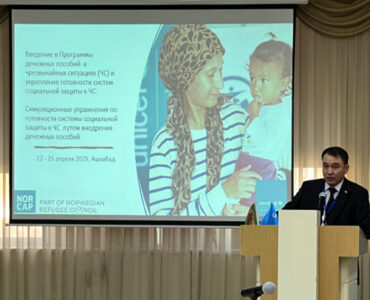The national strategy of Turkmenistan on climate change is data-scarce with no targets and measurable commitments. Country’s nationally determined contributions (NDCs) are not publicly available. The government has not pledged to cut the methane emissions. The strategy has no budget and funding commitment.
Turkmenistan has recognized the importance of addressing climate change and has developed a national strategy to address the issue in June 2012, following the conclusions of the 4th Report of the Intergovernmental Panel on Climate Change. Afterwards, following the conclusions of the 5th Report of the Intergovernmental Panel on Climate Change published in 2014, Turkmenistan set on to update the national strategy due to emerging new data on climate change.
This is a summary of the 62-page strategy report titled “National Strategy of Turkmenistan on Climate Change”. This updated report, published on May 3, 2021, was prepared by the Ministry of Agriculture and Environment Protection of Turkmenistan, with the support of UNDP Turkmenistan, and made available in Turkmen, English, and Russian. Overall, Turkmenistan’s national strategy on climate change is declarative in its format. It declares to reduce and stabilize GHG emissions until 2030 and to adapt to the impacts of climate change through promoting clean, renewable energy, sustainable land management practices, and fuel-efficient transportation. It seeks to involve a wide range of stakeholders in the process of addressing climate change.
Quantitative data from the report
The report is data-scarce with no defined targets and measurable commitments.
Emissions: The report estimates that the nation’s GHG emissions have grown from 35 million tons of CO2 (MtCO2) in the year 2000 to roughly 87 MtCO2 in 2017 (Fig. 7), at roughly 5.5% compound annual growth rate.
Temperature: The historical data collected on air temperature shows an average increase of almost 2℃ throughout Turkmenistan (Fig 1) from 1950s to 2010s. Climate models, developed to understand how the climate will possibly change over time, show that the temperatures are likely to continue increasing this century by further 4℃ and precipitation is likely to drop sharply after 2030-2040 (pg. 19-20).
Droughts and low water level: These changes will entail dramatic changes to the climate of Turkmenistan and droughts are recognized as the greatest risk to the socio-economic well-being of the country, as is already evident in the frequency of low water years in Amu Darya and Murgab rivers. Droughts can severely impact the agricultural sector, which provides about 10% of the GDP in the country’s economy (pg. 26).
Floods and mudflows: The rising air temperature may also exacerbate the adverse effects of the naturally occurring floods. The increasing rate of snowmelt at the source of Amu Darya in the Pamir Mountains in eastern Tajikistan can lead to frequent floods in the river, and irregular rainfall can lead to mudflow activity in the Sumbar and Etrek rivers (pg. 22).
Proposed government strategies
Donate to support Turkmen analysts, researchers and writers to produce factual, constructive and progressive content in their efforts to educate the public of Turkmenistan.
SUPPORT OUR WORKThe national strategy outlines both adaptation and mitigation strategies to minimize the risk and damage of climate change.
Adaptation strategies include measures for:
- public health via raising awareness, developing early warning systems for natural disasters and the implementation of measures to protect infrastructure from extreme weather events with improvement of hydrometeorological observations of weather and climate change in the territory of Turkmenistan
- agriculture and water economy via modernization of irrigation systems and introduction of advanced desalination methods
- land resources via strict observance of crop-rotation and prevention of soil erosion and desertification
- flora and fauna and forestry via strengthening state control over the protection of ecological systems.
The mitigation strategy aims to reduce greenhouse gas emissions in:
- the oil and gas complex via carrying out measures to reduce leaks during extraction, transportation, storage and processing of natural gas, which made up 36% of total greenhouse gas emissions in 2010 (Fig 6)
- power sector via switching to more efficient combined cycle gas turbines, limiting GHG emission in electricity generation (possibly via carbon capture and storage), investments in the power grid, creation of economic incentives for the use of alternative energy sources and implementation of measures for the use of renewable energy sources, such as solar and wind power
- industrial sector via creation of economic incentives for energy conservation and energy efficiency
- transport sector via supporting development of public transport, regulating energy efficiency and the age of the vehicle fleet, switching to compressed natural gas or liquified petroleum gas as a fuel, and development of electric vehicles
- residential sector via introduction of energy monitoring and energy management, use of energy-efficient lighting systems, construction of energy-saving buildings, increasing public awareness, development of the state waste management program.
Turkmenistan’s Nationally Determined Contributions
The strategy will be realized through the Paris Agreement Implementation Plan and preparation of the updated Nationally Determined Contribution (NDC), which is meant to demonstrate the successive efforts of the nation to curb emissions and to adapt to the impacts of climate change. NDCs include the policies and measures the governments intend to implement in response to climate change and they must be updated every 5 years to reflect the latest findings in climate science. The latest publicly available NDCs of Turkmenistan is from 2016. Although one of the requirements of the Paris Agreement is to ensure transparency, the government still has not made public the updated NDCs of Turkmenistan, announced in May 2022.
Methane pledge
Turkmenistan still has not signed the methane pledge, a globally concerted effort to reduce methane emissions at least 30% from 2020 levels by 2030, announced in November, 2021 at the COP 26 in Glasgow. Turkmenistan is perhaps the biggest methane emitter absent from the list of 150 signatories of the pledge, despite the proclamations at COP 26 by the then vice prime-minister Serdar Berdimuhamedov that “the nation pays special attention to the reduction of methane emissions”.
Uncertain funding mechanisms
The strategy will involve various stakeholders, including local governments and ministries. The financing of implementation mentions access to many financial mechanisms from international funds and development banks such as the World Bank, the Asian Development Bank, the European Bank for Reconstruction and Development and many more, as well as national sources such as the state budget of Turkmenistan, private capital, etc. However, no estimates or figures were provided regarding the level of investments and commitments needed to implement the strategy.






